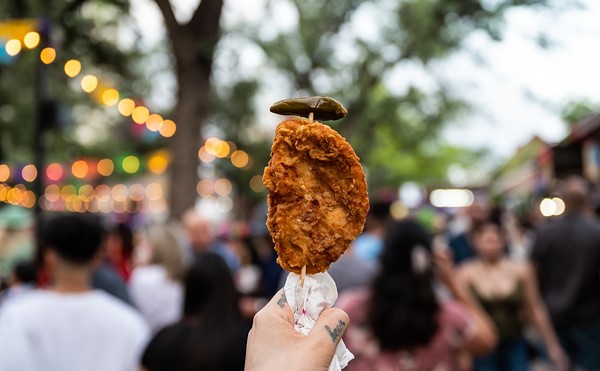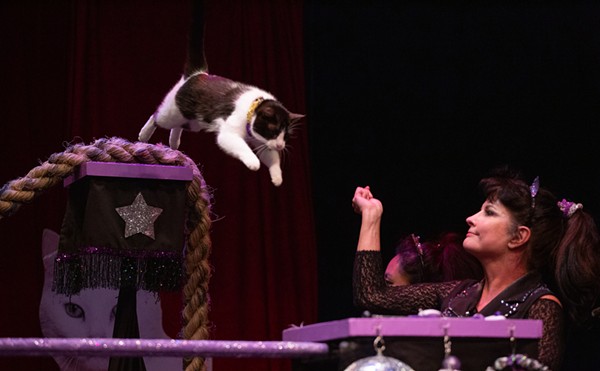I knew amazingly little about the career output of Robert Indiana. This is a damn shame. Luckily, not only is the McNay’s career retrospective “Beyond Love” grand, curious and illuminating, it’s also entertaining as hell. Plus, Robert Indiana’s body of work is as close to a representative history of postwar 20th-century art movements as that of any living artist I can think of, without being derivative or survey-like. It addresses, tweaks and subverts American society contemporaneously, not retroactively; one gets the sense the works are not inspired by the great social questions of the day but are rather part of the questioning itself.
With the artist now 85 years old, it’s sheer historic luck that Indiana’s output covers the early 1950s to the early ’90s, and a real coup that the exhibition includes works representative of this magnificent span. It helps describe Indiana as his own, wide-ranging artist rather than merely the Pop Art footnote his most famous work has relegated him to.
The front gallery showcases his early work. From the ’50s comes a diptych of paintings of totemic black humanoid figures with giant heads hovering above a gold-leafed, highly textured background. It’s dark stuff, to which he added, 40 years later, text alluding to biblical Nebuchadnezzar. They remind me of book covers—the literary ones, or Saul Bass’ credit sequences for Hitchcock films. In their simplicity and graphic strength, the works are era-specific but foreshadow the oncoming hard-edged simplicity and cultural allusiveness of Pop. He wasn’t Pop yet … but neither was Pop.
Also of this era and in this gallery, deliberate and balanced assemblages of found wooden elements. Indiana continued to work in wood, erecting phallic pillars inspired by Classical podium sculptures called herms. While not his most notable work, his wooden sculptures are strongest as material documents: Some of the early ones playfully incorporate Duchamp-ian wheels. They resonate with Rauschenberg’s combines of the same period, too.
Indiana’s work of the 1960s is his most famous, of course. He seems all at once to grasp his brand—because that’s what it is—and express its social principles and stylistic nuances. In paintings like The American Gas Works (1962), The Figure Five (1963) and The American Sweetheart (1959-1961), simple, strong, precisely sectioned canvasses combine clean fields of punchy color, elegant geometric constructions alluding to highway and railway signs, maps, other civic insignias and the all-important text as conveyor of meaning and graphic element. Words recur throughout his oeuvre, most three-lettered: EAT. DIE. HUG. ERR. These universals are made more poignant by Indiana’s particulars; he was a gay man pre-Stonewall, the son of a dying mom who refused to extend her life by taking food, and a kid whose Christian Scientist upbringing inculcated God is Love, while projecting same-sex love as sinful error.
We arrive at LOVE fairly early into the semi-chronological arrangement of works (further on, the works tend to be grouped by theme), in both painting form and as a delicious aluminum sculpture you’ll want to take home with you. LOVE is synonymous with a Pop-ulist 1960s, a witty ecumenical statement shared by everybody and anybody. The massive sculpture forms in New York and Philadelphia, LOVE on a postage stamp, LOVE on the placards of political protesters, LOVE on T-shirts and skateboards and coffee mugs—the image is now so iconic that the word scarcely covers it. It’s often said that Indiana’s reputation falls victim in popular consciousness to the success of this image. The truth is, it started as a freelance job; he made the original design as a Christmas card for the Museum of Modern art in 1964. Though it is just one part of Indiana’s greater whole, it is emblematic of his ability to marry graphic art to contemporary rigor, and as a kind of object lesson in the Warholian blurring to come.
Indiana isn’t just an inheritor, but a generator. While his clean, simple, declarative text can be seen as reaction to the scribbled graphomania of DeKooning, in absorbing his gospels of ERR, EAT, DIE, LOVE, I thought of the SILENCE=DEATH iconography of Act Up in the 1980s. The nimble foregrounding of text as image can be found later in the work of contemporary artists Barbara Kruger and Jenny Holzer.
One of the great, unexpected pleasures of “Beyond Love” is its exuberant ambition as a material documentation of midcentury New York City, just at the moment the city emerged as the contemporary-art beacon of the world. It seems poetic that in the years after Indiana decamped his New York studio in the Coetzee Slip, that Melville-era shipping inlet (whose wooden remnants he used in his work) was paved over to make way for Wall Street’s expansion.
Robert Indiana: Beyond Love
$10-$15; free for members; Free 4-9 pm Thu
10am-4pm Tue, Wed, Fri; 10am-9pm Thu; 10am-5pm Sat; Noon-5pm Sun
McNay Art Museum
6000 N New Braunfels
(210) 824-5368
mcnayart.org
Through May 25















